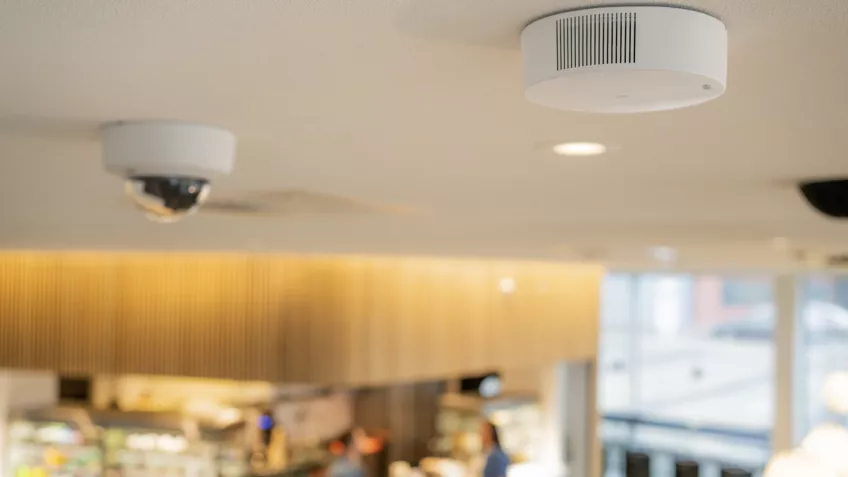
A greater focus on health, sustainability, and productivity, means that the need for optimal indoor environments in commercial spaces has never been more critical. Indoor air quality (IAQ) plays a major role in the well-being of employees and visitors, impacting everything from health to performance. Indoor air quality sensors are becoming an essential part of solutions to monitor and improve air quality in “smart” commercial buildings.
As highlighted by independent industry analysts such as Memoori, connected devices and sensors in commercial buildings – together part of the Internet of Things (IoT) – is a significant area of growth. Foundational to the vision of “smart” commercial buildings are a new generation of connected sensors, providing insight and data on every aspect of a building’s operations, from lighting to security, from heating to occupancy.
Alongside other connected technologies, including video surveillance cameras, audio, and access control solutions, these support enhanced building security, safety for occupants, and improved operational efficiency. One emerging area of focus are environmental sensors, including those measuring air quality.
Why indoor air quality matters in commercial real estate
The quality of the air we breathe significantly impacts our health, productivity, and overall well-being. In commercial real estate, where employees often spend many of their waking hours, poor air quality – often also referred to as Indoor Air Pollution (IAP) - can lead to a range of issues. These include:
- Health issues: Research has shown that exposure to pollutants like volatile organic compounds (VOCs), allergens, or elevated carbon dioxide (CO2) levels can trigger respiratory issues, fatigue, headaches, and more severe long-term health conditions.
- Reduced productivity: A study by Harvard University found that employees in poorly ventilated environments with high levels of CO2 may experience decreased cognitive function, concentration, and energy.
- Compliance with regulations: As environmental standards become more stringent, especially with a focus on sustainability and employee well-being, commercial buildings are increasingly required to meet specific air quality standards.
- Tenant turnover: Whether it’s an office, retail space, or multi-tenant building, IAQ plays a significant role in tenant retention. Building owners and operators who prioritize air quality are seen as more responsible and tenant-friendly, potentially leading to higher occupancy rates and lease renewals.
The increasingly critical importance of the issue has led to the use of connected technologies to help measure and monitor IAQ. Central to these solutions are IAQ sensors.
What are indoor air quality sensors?

IAQ sensors are devices designed to measure various air pollutants and environmental parameters in a building. These sensors can detect levels of particulate matter (PM2.5 and PM10), carbon dioxide (CO2), volatile organic compounds (VOCs), temperature, humidity, and even levels of carbon monoxide (CO). By continuously monitoring these parameters, IAQ sensors provide real-time data to building managers, helping them make informed decisions about ventilation, filtration, and other methods of improving air quality.
The role of IAQ sensors in commercial buildings
IAQ sensors provide commercial real estate professionals with the information and data they need to actively monitor and improve air quality.
Through continuous, real-time monitoring of air quality levels, should any pollutant reach an unsafe threshold, building management can receive instant alerts. This allows for immediate action to prevent health risks or discomfort for occupants.
The information provided by IAQ sensors allows property managers and building owners to make data-driven decisions about how to optimize air quality. For example, sensors can identify specific areas that require better heating, ventilation, and air conditioning (HVAC) system adjustments.
Making system adjustments in specific areas without needing to operate at full capacity throughout the entire building can help optimize HVAC system energy usage, while also potentially extending the life of equipment.
As a result, IAQ sensors contribute to a building’s overall sustainability goals by improving energy efficiency, reducing unnecessary waste, and positively impacting employee well-being.
In addition, many commercial real estate owners seek green building certifications like LEED (Leadership in Energy and Environmental Design). IAQ sensors can play a crucial role in meeting the indoor environmental quality requirements for these certifications, showcasing the building owner’s commitment to sustainability.
Finally, as businesses increasingly adopt wellness-focused strategies, air quality becomes an essential part of ensuring a healthy indoor environment. IAQ sensors provide a measurable way to guarantee that air quality standards are met, directly benefiting tenant satisfaction and employee well-being.
The future of IAQ sensors in commercial real estate

The role of IAQ sensors in commercial real estate will continue to evolve as technology advances.
Sensors will become more integrated with other “smart building” systems, including automated lighting, heating, and cooling. This integration will enable buildings to automatically adjust to optimize air quality, energy efficiency, and occupant comfort.
With the help of AI and machine learning, such sensors could predict potential air quality issues before they occur, helping building managers perform proactive maintenance on HVAC systems.
Building owners may also leverage sensor data to engage tenants and employees by providing real-time information on air quality conditions. Some may even integrate IAQ monitoring into tenant-facing apps, empowering people to monitor and improve their own work environments.
An essential part of a healthy environment
Indoor air quality is no longer just a "nice-to-have" factor in commercial real estate; it is a key element that affects tenant health, productivity, energy efficiency, and sustainability.
By incorporating IAQ sensors into commercial buildings, owners and managers can ensure that their spaces are healthy, comfortable, and in compliance with evolving regulations.
As technology continues to advance, IAQ sensors will play an even more vital role in shaping the future of the commercial real estate industry, creating environments that prioritize both the health and well-being of all who occupy them.
